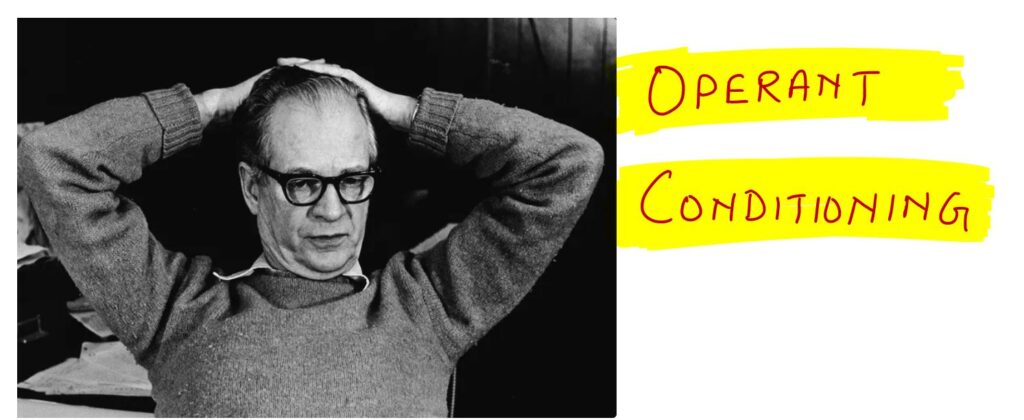Operant Conditioning Theory of Learning

Operant conditioning is a method developed by American psychologist B.F. Skinner, also known as Instrumental conditioning because organisms use certain operations or actions to find a solution.
This method of conditioning focuses on the Response—Stimulus (R-S) connection. According to Skinner, organisms tend to repeat responses that are followed by favourable consequences, and avoid repeating responses that are followed by neutral or unfavourable consequences. For example, an individual might work hard (the response) because they know they will receive a promotion (the stimulus) (R-S connection).

According to the theory, behavior can be classified as desirable or undesirable.
Desirable behavior
It is followed by positive reinforcement, such as a reward, will increase the likelihood of that behavior being repeated in the future. For example, in a business setting, if an employee consistently meets his targets, they may receive a bonus as positive reinforcement, encouraging them to continue performing well. Desirable behavior can also be strengthened through negative reinforcement, which involves removing an aversive stimulus to increase the likelihood of the behavior being repeated. For example, an employee who arrives on time to work may avoid being reprimanded, thus strengthening their punctual behavior through negative reinforcement.
Undesirable behavior
It can be weakened through extinction, which involves withholding positive reinforcement. For example, if an employee consistently misses their targets, their bonus may be gradually reduced, leading to the extinction of their poor performance. Undesirable behavior can also be discouraged through punishment, which involves applying an aversive stimulus. For example, an employee who consistently arrives late may receive a warning, serving as punishment for their tardiness.
Avoidance
Avoidance is a type of behavior that occurs when an individual engages in an action to avoid a negative consequence. For example, an employee who is afraid of being fired might work extra hard to avoid being let go.
Behavior modification
Behavior Modification is the process of using reinforcement and punishment to change behavior. This may involve using positive reinforcement to encourage desirable behaviors or punishment to discourage undesirable behaviors. The goal of behavior modification is to improve performance and achieve specific objectives.
Schedules of Reinforcement
The schedules of reinforcement refer to the pattern in which reinforcement is delivered following a behavior. Here are brief explanations of the different types of schedules with examples:
Continuous reinforcement: In this schedule, every instance of the desired behavior is immediately followed by reinforcement. For example, if an employee receives a bonus every time they complete a task, this would be an example of continuous reinforcement.
Fixed ratio: In this schedule, reinforcement is given after a specific number of instances of the desired behavior. For example, an employee might receive a bonus for every 10 tasks they complete, representing a fixed ratio schedule of reinforcement.
Variable ratio: In this schedule, the number of instances of the desired behavior required for reinforcement is unpredictable. For example, a salesperson might receive a commission for every third sale they make, but the exact number of sales required for a commission is unpredictable, creating a variable ratio schedule of reinforcement.
Fixed interval: In this schedule, reinforcement is given at regular, predictable intervals of time. For example, an employee might receive a performance-based bonus every six months, representing a fixed interval schedule of reinforcement.
Variable interval: In this schedule, the intervals between reinforcement are unpredictable. For example, an employee might receive unexpected bonuses at random intervals, creating a variable interval schedule of reinforcement.
UGC NET Previous Year Questions (Operant Conditioning)
1.) Which of the following learning theory is also known as Instrumental conditioning?
(A) Classical Conditioning
(B) Operant Conditioning
(C) Pragmatism
(D) Moral Development
ANS. B
2.) Match the List I with List II: (UGC NET 24 Dec Morning 2021)
List I
a. Classical conditioning
b. Operant conditioning
c. Social learning theory
d. Constructivism
List II
i. Albert Bandura
ii. Ivan Pavlov
iii. Lev Vygotsky
iv. B. F. Skinner
Choose the correct answer from the options given below:
Codes
(A) a‐ i, b‐ iii, c‐ ii, d‐ iv
(B) a‐ iii, b‐ ii, c‐ iv, d‐ i
(C) a‐ ii, b‐ iv, c‐ i, d‐ iii
(D) a‐ iv, b‐ i, c‐ iii, d‐ ii
ANS. C



